How Old Is the Tradition of Fire Crackers in Diwali
So widespread is this myth that gunpowder is popularly known as one of “the “Four Great Inventions” of China”. However, this myth starts falling apart when we examine Chinese sources themselves for the origin of Gunpowder. According to Chinese sources themselves, an Indian Buddhist monk brought gunpowder technology to China. In 664 CE, he discovered soils in China containing Saltpeter (primary constituent of gunpowder). Of course, this is not to say that the Chinese have no contribution to Gunpowder technology. They improvised it & made innovations. However, the initial knowledge of Gunpowder came to China from India. Even Scholar Roger Pauly, a hardcore Sinophile, admits “Indian inspiration”. Chinese studies of the Chemistry of saltpeter show evidence of Indian origin.
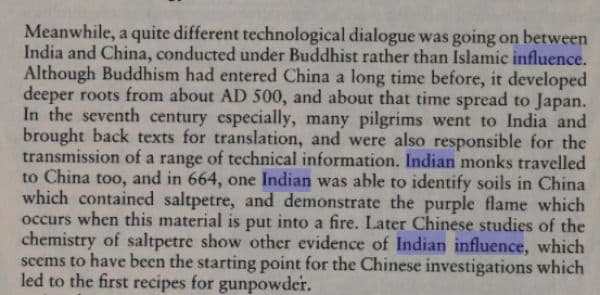
For those familiar with Indian literature, this should hardly come as a surprise. Indian literature contains ample references to what could be seen as an early form of Gunpowder. Let us examine these references before jumping into the discussion about Dipavali. Vaisampayana, the narrator of Mahabharata, describes the manufacture of smoke balls by ancient Indians using what many scholars see as Gunpowder. According to a medieval commentator of the verse, the aforementioned smoke balls were indeed made of Gunpowder.
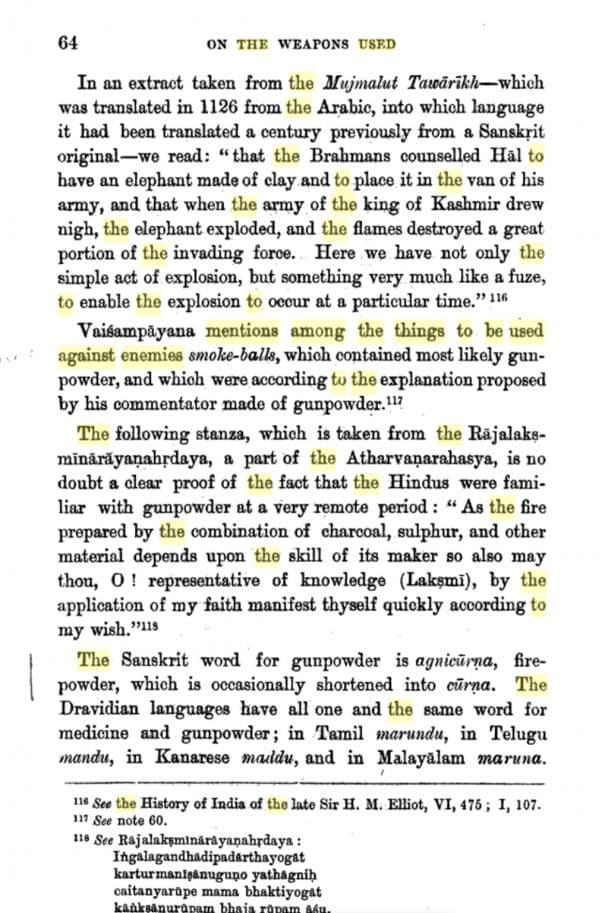
Atharvanarahasya mentions the use of charcoal, sulfur, and saltpeter to make gunpowder, which are the same ingredients used even today to manufacture Gunpowder. In fact, workers at Sivakasi use these ingredients to make fireworks even today.
Ancient Indians used Saltpetre (Agnichurna), the major constituent of gunpowder, to make firecrackers (ulkah) on Diwali.“Gunpowder originated in Ancient India”- Indologist Dr. Gustav Oppert. While it is true that the use of Gunpowder in matchlocks proliferated in the middle ages. Ancient Indians used Saltpetre (Agnichurna) in mining and warfare. Kautilya already mentioned it in Arthashastra as a weapon of war (4th century BC) long before Mughals were born.
A look at how Diwali fireworks are manufactured by traditional makers to this day is very revealing. This video shows the traditional maker of fireworks from Andhra in action. This is a simple form of crackers but the use of such crackers is very widespread.
In the above video, the Andhra maker uses basic ingredients to make simple fireworks.
- Suryakara (सूर्यकार, Telugu సురేకారము)= Saltpetre
- Gandhaka(गन्धक, గంధకము)= Sulphur
- Sand
These were known in India since the ancient age. Why would Indians borrow this from anywhere?
The etymology of the ingredients tells us about their origin. The Indian firecracker workers of Andhra and Sivakasi use the Indic Saltpetre (सूर्यकार) whose origin is Sanskritic. They do not use the word Shora (शोरा شورہ) which is Persian for Saltpetre imported in the medieval age.
From the time of Arthashastra down into the Medieval ages, northwest Indians continued to use gunpowder in warfare. A Chinese text dating back 7th century CE attests to the use of Gun Powder in northwest India. This has been mentioned in “Military Transition in Early Modern Asia, 1400- 1750”.
According to the old tradition of Muslim Arabs themselves. They learned the use of Gunpowder (barud) from Indians. They received their earliest Gunpowder supplies from India.
When Timur, the ancestor Abbu of Mughals invaded India in 1398 CE, Indian troops shot his army with rockets and fireworks. It shocked his troops and they were beaten in the initial engagement. Even in the 13th century, a Mongol foreign ambassador to India was greeted with 3000 celebratory fire cars which are much reminiscent of Indian firework celebrations during Dipavali and Kartika Purnima.
Remarkable sculptures from Hoysaleswara Temple (Halebidu, Karnataka. built c.12th century) show warriors using rockets (fire arrows). Arrows were tipped with Gunpowder/flammable combustibles. They were known as Agnibanas and used together on a launching pad in wars.
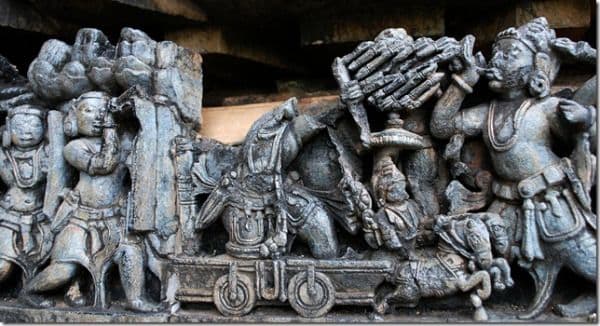
A sculpture from Halebidu (12th century) depicting rocket warfare in Ancient India. Notice the launching pad that is holding the missiles/combustible arrows. This busts the myth that Mughals bought gun powder in India.
While ancient Indians did use Gunpowder, they did not have a projecting weapon like a matchlock that could be integrated with the fire. They simply used to tip their arrows with Gunpowder and shoot at the enemy.
At the core of Dipawali is a belief that our departed ancestors would come back on this night. It is believed that on the night of Chaturdashi & Amavasya, the Pitrs would come back. It is the light & noise which show them the path in the dark. Hence we illuminate our houses.
The Skanda Purāṇa is the largest of the 18 MahāPurāṇas. It describes the rites to be performed on Dīpāvalī and it mentions this belief.
The Vaiṣṇava-khaṇḍa of Skanda Purāṇa says
उल्काहस्ता नराः कुर्युः पितॄणां मार्गदर्शनम्।
नरकस्थास्तु ये प्रेतास्ते मार्गं तु व्रतात्सदा ।।
“Diwali should be celebrated by holding Ulkas in our hands. This will show the path to our ancestors.”
What is “Ulkas”? The meaning of this word has changed with time. GV Tagare translates it as “firebrands”. Note that firecrackers in their early form were firebrands.
Analyzing such verses, professor of Sanskrit and historian Dr. GV Raghavan concludes that an early form of crackers has been a part of Dipawali celebrations since the earliest times. He says that their religious purpose was to illuminate & resonate the path of departed pitrs.
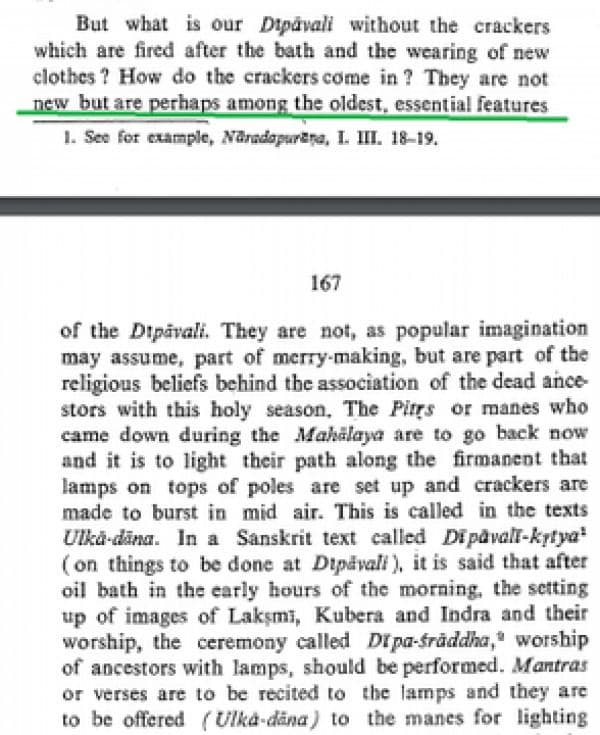
In her thesis, Indologist Tracy Pintchman says that the core of Diwali festivity is illuminating the path of deceased ancestors with firecrackers and lights.
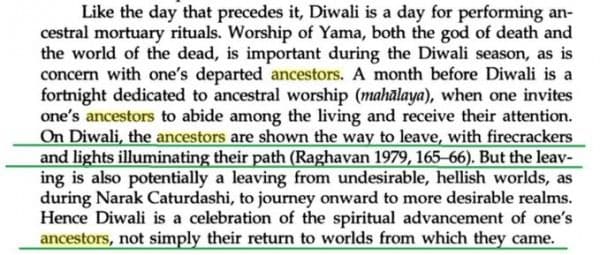
This is also corroborated in Ananda Ramayana. Ananda Ramayana is an epic that has been traditionally been attributed to Valmiki. It mentions that fireworks were burst during Lord Rama’s homecoming. It mentions crackers that burst and shine in the sky (gaganantarvirajitan). As against this, it is objected that Ananda Rāmāyaṇa is a work of the 15th century. But these dates have been assigned by the same Indologists who assigned a date of 500-100 BC (post-Buddha) for Valmiki Rāmāyaṇa. Clearly, this is at odds with tradition which puts both in Treta Yuga.
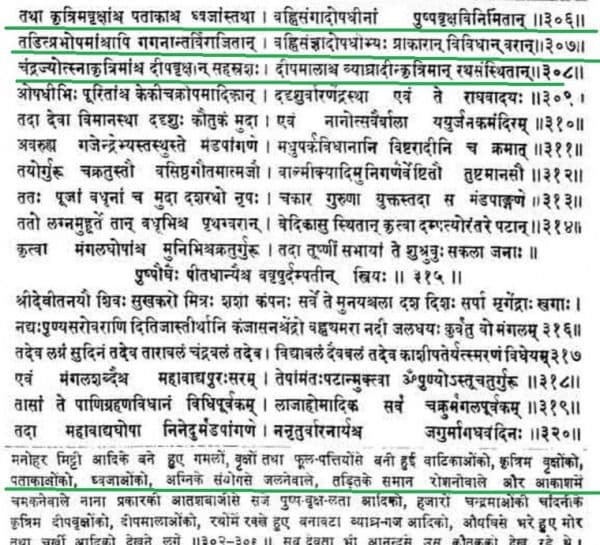
Hard archaeological evidence for all festivals has been allusive in a tropical & frequently re-populated civilization like India. These are wall murals(of a possible later date) on the 9th-century Tyagaraja temple in Tamilnadu. They depict festival celebrations with firecrackers.
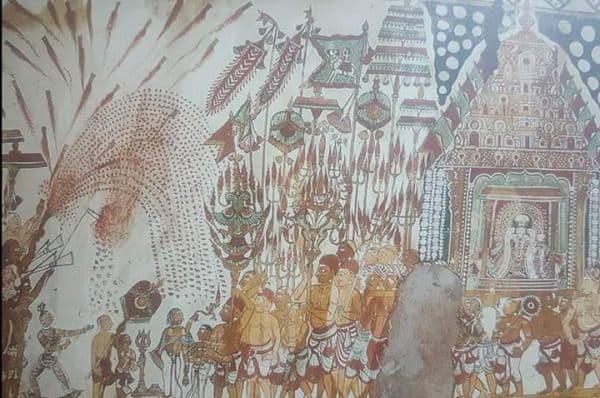
Bogar Sattakandam is a book attributed to Tamil Siddha Saint Bogar. He is traditionally dated to 500 BC but some modern scholars have put him in 5-7th century CE. Dipavali firecrackers are clearly described in this book. Bogar describes the method of preparing the Saltpetre solution(Vediuppu Cheyanir) for all types of Sarakku Vaippu. Fireworks, gunpowder, etc. are all described.
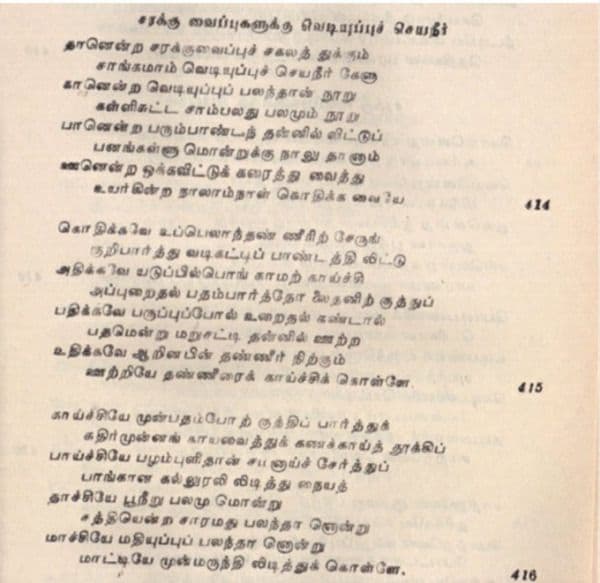
An objection is raised that these paintings are late. The earliest available of these Krishna-fireworks series of paintings comes from the 16th century. But that is precisely the point. Hindu art & tradition hasn’t seen firecrackers as an alien custom that was absent in Krishna’s era.
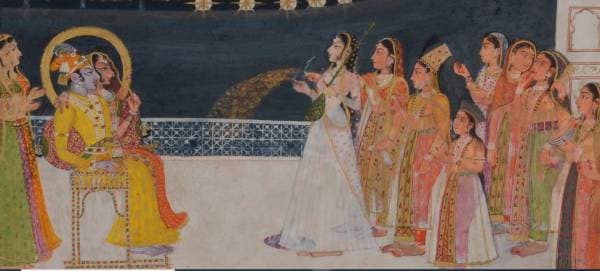
Is it possible they remembered these medieval fireworks as a successor of something which had ancient roots in India and in their memory had been an integral part of Hindu culture? Hindu civilizational memory does not see Dipavali firecrackers as an alien import. Rather the opposite.
As another example of civilizational memory, the great Marathi Saint Eknath (16th cent CE) describes firecracker celebrations in the wedding of Rukmini and Krishna. He describes Agniyantra, Havai, Sumanmala, Chichundari, Bhuinala, etc. They can be found even today in Deccan.
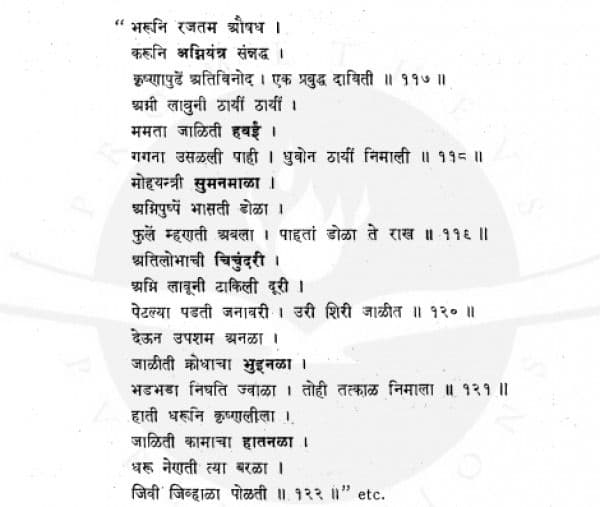
The great Maharashtrian saint & Shivaji Maharaj’s Guru, Samarth Ramdas also describes various kinds of fireworks burst by Lord Rama’s army in his Ramayana. These firecrackers include havaiya, nala, phula(phuljhari), ghosha etc.
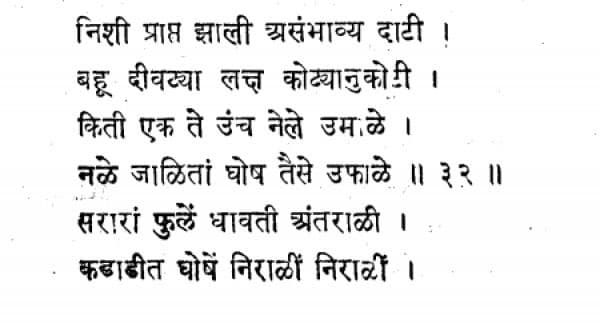
If we assume firecrackers were imported in the Muslim age, the inevitable conclusion is that all great Hindu painters, poets &scholars were collectively wrong & deluding themselves when they mentioned fireworks in ancient India. But there is another, more plausible possibility which does not require denying every evidence. Skanda Purana says Diwali should be celebrated by holding Ulkas in our hands. These ulkas were mostly likely firebrands that served two purposes.
- Made noise
- Illuminated sky
Diwali celebration with firebrands was its earliest form and must date back to thousands of years. Even today, such Diwali firebrands can be found. Take Kaunriya Kathi of Odisha. It is a basic Diwali firebrand without gunpowder. But it illuminates and makes noise.
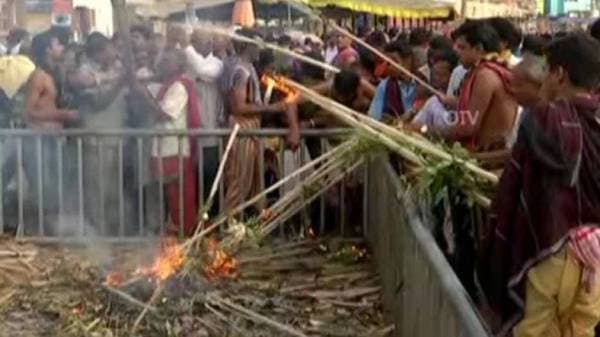
Such firebrands illuminated the sky which could explain why some commentators described उल्काहस्ता of Skanda Purana as दीप. This was an older, original form. Traces of it can be found in some medieval paintings. This painting from Mir Kalan school depicts what is close to its older form.
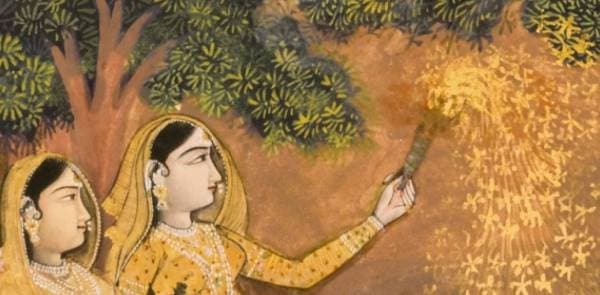
At one point, definitely before the Muslim age, Saltpetre was incorporated into firebrands. While the use of such crackers gradually became widespread, more conservative ones persisted with the older form of firebrands which explains why not many ancient texts describe this innovation.
The concept was to use a combustible substance on the night of Dipavali to make a lot of noise, illuminate the sky and show the path to our departed ancestors. This is mentioned in the Skanda Purana itself & is true irrespective of whether or not Ulka means modern firecrackers. What does it all show? With the advancement of technology, everything changes. But the basic concept of using combustibles to make noise and illuminate the sky on the day of Dipavali existed since ancient times. This was not a foreign import or medieval 16th-century concept.
Source: